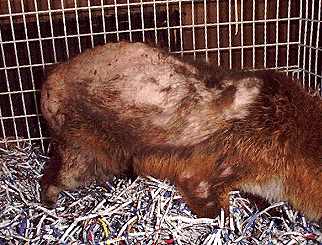
Sarcoptic
mange is the single most common disease in British foxes.
Sarcoptes
Scabeii has a number of sub-species that produce infections in
different species. That which causes canine, or dog mange (all
too often incorrectly referred to as fox mange) is different
to that which produces similar infections in cats and horses
or scabies in humans. While the mites need hosts on which to
feed and breed, they can survive in the environment for a
considerable period. Being microscopic, it is virtually
impossible to locate the source of infection or guess at the
point the affected animal contracted the disease in the first
place.
Re-infection
It
is a mistake to think removing an infected animal from the
area will make any difference. Parasites will still be present
locally and the risk of re-infection may remain. Rather than
removing an animal, it is more sensible to think in terms of
treating it. On average, we receive twenty enquiries per day
from householders worried about "their" mangy foxes.
Many are convinced the animals are doomed and are delighted to
learn the condition is easily treated. Depending on the level
of infection, treatment given to captive foxes is usually
successful, with two injections of Ivomec or Panomec given
over a two week period along with antibiotics to deal with any
skin infection.
Avoiding
Stress
In
many cases, the animal will have been cage trapped, but, in
order to avoid the stress of capture, our policy is not to
trap a fox suffering with minor mange if it can be
successfully treated in its own environment. Where feasible,
Ivomec or Panomec may be applied orally by adding to food. But
this depends on the predictability of the affected animal's
feeding pattern, or whether it can be individually targeted
when other foxes may share the territory. Accurate targeting
is absolutely vital with veterinary products. If neither
trapping nor treating on site with veterinary medication are
suitable options, where does that leave you? More importantly
where does it leave the foxes?
Targeting
and Results
Where
a number of foxes are to be treated or where they cannot be
targeted individually, treatment in the wild is, at best, a
shot in the dark. One dare not put out too much of the
veterinary medications for fear of an animal ingesting a
dangerous level, so a safer option has to be considered.
Following trials in association with various pharmacists and
practitioners, we can confidently recommend a homoeopathic
treatment consisting of arsenicum 30c and sulphur 30c.
"But does it work?" we hear sceptics ask.
Some
spectacular recoveries have been achieved and we have found
the treatment proven effective on foxes suffering up to 70%
mange, which covers most reported cases. While positive
results on foxes suffering more than 70% visible mange are
less convincing, it nevertheless adds another string to the
wildlife rescuer's bow. For those who consider complimentary
treatments akin to voodoo - the placebo effect that only works
because you believe in them - think about it. For animals, the
placebo effect does not exist. Animals don't have an opinion!
Information by the Fox Project. Web
site.
If the fox is
just holding its leg off the ground or is only occasionally
observed to place the leg on the ground, then it would seem
to be sprain or other minor injury. In either case the
homoeopathic treatment (Arnica 30c) they supply should help
to relieve any pain and reduce any swelling. The treatment
is a homoeopathic remedy so there is no fear of overdosing
the fox and it is no danger to any other animal.
Dosage:
Administer four drops onto either a jam, honey or peanut
butter sandwich. The fox will take this with relish and the
local cat population will leave it alone, foxes love sweet
things - cats don't! Give the four drops daily for ten
days, unless the leg appears better before this. If the fox is
still limping badly after treatment please do get back to
them. Information by Derby Fox Rescue Web
site
Thank you to the
fox project & Derby Fox Rescue for the information top
Photo by Derby Fox Rescue.
Please note
treating foxes for Sarcoptic Mange and for Sprains
can be put in Sandwiches this is the way I do it my self
with the foxes I feed.
The Country's
Biggest Fox welfare Society Web
site The
fox web pages on this page can help with your fox
Problems up and down the country or out side the UK. If you
need help and have a camera then you can take a photo of the
problem a Digital camera is best for e-mailing the Photo.
The
RSPCA say's if you find a injured wild animal to contact
them as well on their 24-hour national Cruelty and advice
line on 0870 55 55 999 as soon as possible.
When
finding an injured animal this is what you should do Seek
advice from Hydestile Wildlife on 44
- 01483 - 860313.
You can call us for details of your nearest
Hydestile Wildlife. Web
page.
I
do fully recommend every site on this page if you find a
injured animal and need expert help on the best way to care
for it till the vet or animal rescuer gets to your location
it is well worth programming some of the local vet's phone
numbers in to your mobile phone. As well as your nearest
Animal Rescue Centre.
www.anthony-dacko.net
www.anthony-dacko.net/rss..xml
